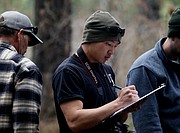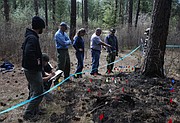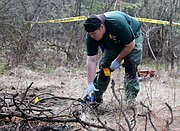IDL cracks down on human-caused fires
By BRIAN WALKER
Staff Writer
POST FALLS — The Idaho Department of Lands hopes its recent crackdown on suspects of human-caused fires will spark residents to take notice and caution and ultimately reduce the blazes.
Nearly 80 percent of wildland fires last year on state, private and federal lands protected by IDL — 224 of the 282 incidents — were human-caused.
That trend has caused IDL to have a renewed focus on finding the culprits, holding them accountable and recovering taxpayer funds used to fight the fires, said Sharla Arledge, IDL spokeswoman.
"We have always investigated fires and billed for negligent fires," she said. "However, during the 2017 fire season we reorganized how we track and bill. The result was an increase in the number of bills.
"Some people were surprised when they received a bill. We really do investigate every fire, and we really do send bills if negligence was involved."
IDL sent out six bills statewide in 2016, but the number climbed to 24 with the reorganization in 2017. More than 40 bills — and counting — have been sent out for the 2018 fire season. A total of 7,766 acres under IDL protection burned in 2018.
IDL anticipates sending out more than $1.3 million in bills for the 2018 fire season. In 2017, $3.4 million in requests were sent out.
"The bills are for all costs associated with fighting the fire such as fire crews and air support," Arledge said. "Investigation costs are not part of the bills. We only send bills if we believe there is negligence or willfulness."
The only rehabilitation to the landscape included in the costs is repairing dozer lines and other minor repairs for damage caused by the firefighting effort, Arledge said.
Bill amounts vary widely based on how large the fire grew and the amount of resources used on the fire. The smallest bill sent by IDL for 2018 so far was $155. One of the largest will likely be about $500,000.
The money recovered goes into a fire preparedness fund that allows IDL to hire firefighters and receive fire equipment.
Michael Denney, an IDL fire investigator, said the agency is required under code to recover as much of the taxpayers' cost to fight human-caused fires as possible.
IDL sends out an initial letter that residents or companies may be facing a bill for the fire. They are then sent a bill asking them to pay within 30 days and payment plans are accepted. If the recipient does not respond, another bill is sent.
The fourth letter, if required, states that the Attorney General's Office intends to file suit.
"We give them plenty of opportunity (to pay the bill)," Denney said.
As part of its effort to gear up for fire season, IDL trained 30 firefighters from agencies throughout the Northwest on Thursday to become wildland fire investigators. At the field training day outside Post Falls, trainees tested their newly-learned skills by examining a burned area to determine the cause of the fire.
"The number of people trained as investigators has increased as has the level of the training for investigators," Arledge said.
Trainees participated in scenarios, identifying evidence, fire behavior and where it originated from. Markers identifying fire factors were meticulously placed at the scene to develop investigation reports with photos that could hold up in court.
"It's very scientific," said Bob Helmer, IDL's fire investigation program manager. "We have to prove in court that the fire started right there and the evidence took us to that point."
Arson was the leading cause of human-caused fires on land under IDL protection in 2018 with 52. Debris-burning was the cause of 47 fires and equipment use 39. Lightning was the top overall cause with 58 fires.
Helmer said the reason there were more arson fires determined in 2018 than previous years isn't because there were more arsonists, but because there are more investigators and a larger focus on finding the cause.
"We now review every fire," he said. "We're also getting much better at it."
Denney said the biggest message is for residents to use caution so IDL doesn't have to respond and issue the bills for human-caused fires.
"We don't want people's negligent actions to affect their neighbors," he said.
Property owners are encouraged to haul debris to the local transfer station or yard waste recycle center.
If you burn, check local laws to ensure it is legal to burn. Burn permits are required from May 10 to Oct. 20 for controlled-burn activities.
Residents should check the forecast.
"If wind is predicted before, during or after you plan to burn don’t burn," Arledge said.
You should always have a shovel and source of water to extinguish the pile and never leave a burning debris pile unattended. Before leaving the pile, make sure it is cold to the touch.
Check the pile often to make sure that it has not rekindled. This may be for several hours or days depending on the size of material that was in the original pile.







